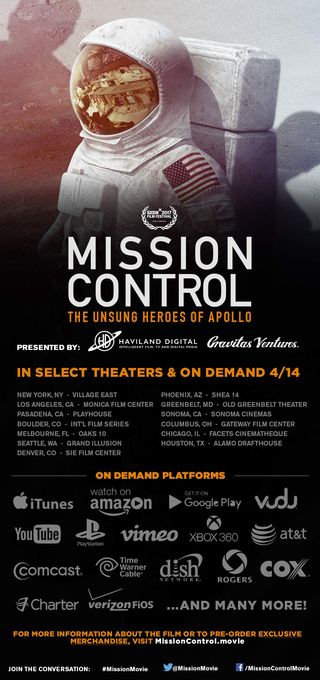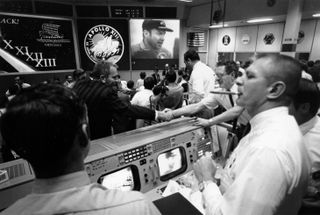Thank You, Houston: Unsung Heroes Star in New 'Mission Control' Doc
A riveting new documentary about NASA's journey to the moon pays tribute to the many behind-the-scenes heroes of the Apollo program. "Mission Control: The Unsung Heroes of Apollo," which hits movie theaters today (April 14), tells the story of the men whose strenuous work put the first astronauts on the moon and launched a new era of human spaceflight.
Along with plenty of archival NASA videos and photos, the documentary features several of the original flight-control staff who worked in the Manned Spacecraft Center (later renamed the Christopher C. Kraft Jr. Mission Control Center) at the Johnson Space Center in Houston during the 1960s and 1970s.
Unlike the stars of the movie "Hidden Figures," the "unsung" figures in this documentary are all Caucasian men. A few present-day female employees at NASA provide brief commentary at the beginning and end of the documentary, but that's the extent of the diversity you'll see in "Mission Control." This isn't surprising; discrimination was the norm during that time, even at NASA. [NASA's 17 Apollo Moon Missions in Pictures]

Directed by David Fairhead, who is known for his work on other space documentaries like "In the Shadow of the Moon" and "The Last Man on the Moon," the new documentary doesn't just chronicle the Apollo missions. It also offers an inside look at the lives of some of the people who worked in mission control.
Mission control was an incredibly stressful place to work. Not only did NASA's Apollo program launch groundbreaking missions, but it also dealt with some major problems.

The troubles started right off the bat, with the Apollo 1 fire, which killed the first three Apollo astronauts before they even launched. Seven years later, Apollo 13 had to be aborted after an oxygen tank exploded while the mission was en route to the moon. Faced with a potentially deadly situation, NASA's mission control team cut the mission short and brought the astronauts home alive. In fact, every Apollo astronaut launched into space made it back safely.
Get the Space.com Newsletter
Breaking space news, the latest updates on rocket launches, skywatching events and more!
Despite the program's major successes, it wasn't exactly smooth sailing inside the mission control team. Tensions ran high, and everything was on the line during spaceflight. Failure was not an option. Sometimes, the team members slept on the floor and wore the same clothes for up to five days in a row. When anxiety levels spiked, people smoked so many cigarettes and cigars that a cloud of smoke billowed into the hallway whenever someone opened the door.
Fairhead's documentary brings to light some of the psychological struggles the mission controllers experienced. Bob Carlton, who worked at mission control from 1964 to 1980, said in the documentary that if he were given the chance to do it all over again, he would pass.
But retired NASA engineer Spencer Gardner said he didn't necessarily agree. During a Q&A session after a screening of "Mission Control" at the Explorers Club in New York, Gardner explained that the job was easier for those who didn't have a family at the time. Most of the men who worked at mission control in the early days were in their 20s, fresh out of college and single, he said.

For a group of young, inexperienced guys hired straight out of school to help land astronauts on the moon, this team was remarkably successful, Fairhead said. At the Explorers Room, Fairhead commended the mission control members for their "amazing competence and ability" and called them "an incredible team that could achieve anything."
Even if you think you already know everything about the Apollo program and don't need to watch another history documentary about NASA, this film is worth checking out. It offers perspectives on the Apollo missions that most people will never hear, and it shows a ton of archival imagery that most people haven't seen before.
Email Hanneke Weitering at hweitering@space.com or follow her @hannekescience. Follow us @Spacedotcom, Facebook and Google+. Original article on Space.com.
Join our Space Forums to keep talking space on the latest missions, night sky and more! And if you have a news tip, correction or comment, let us know at: community@space.com.

Hanneke Weitering is a multimedia journalist in the Pacific Northwest reporting on the future of aviation at FutureFlight.aero and Aviation International News and was previously the Editor for Spaceflight and Astronomy news here at Space.com. As an editor with over 10 years of experience in science journalism she has previously written for Scholastic Classroom Magazines, MedPage Today and The Joint Institute for Computational Sciences at Oak Ridge National Laboratory. After studying physics at the University of Tennessee in her hometown of Knoxville, she earned her graduate degree in Science, Health and Environmental Reporting (SHERP) from New York University. Hanneke joined the Space.com team in 2016 as a staff writer and producer, covering topics including spaceflight and astronomy. She currently lives in Seattle, home of the Space Needle, with her cat and two snakes. In her spare time, Hanneke enjoys exploring the Rocky Mountains, basking in nature and looking for dark skies to gaze at the cosmos.
